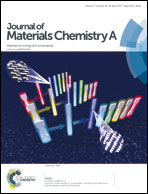Na3V2(PO4)3/C composite as the intercalation-type anode material for sodium-ion batteries with superior rate capability and long-cycle life
Abstract
A Na3V2(PO4)3/C (NVP/C) composite is successfully synthesized by the sol–gel method and examined as the anode material for sodium-ion batteries (SIBs) by means of galvanostatic charge–discharge profiles, cyclic voltammograms, rate performance and cyclic voltammetry comprehensively. The NVP/C electrode delivers a reversible capacity of about 170 mA h g−1 between 3.0 and 0.01 V at a current density of 20 mA g−1 corresponding to three sodium ions insertion/extraction processes. Besides the voltage plateau at 1.57 V, another novel working platform at around 0.28 V is found for the first time in both charging and discharging profiles, possibly owing to the further reduction of vanadium. NVP/C exhibits an excellent rate capability and long-cycle stability with a capacity retention of 62% after 3000 cycles at a high charge rate of 10 C (2 A g−1). Moreover, the intercalation-type Na-ions storage mechanism is proposed on the basis of ex situ X-ray diffraction and high-resolution transmission electron microscopy. Our findings reveal that the NVP/C sample is a promising anode material for SIBs due to its superior rate capability and long cycle life.


 Please wait while we load your content...
Please wait while we load your content...